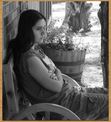Trista Herring Baughman's Blog, page 3
September 12, 2023
Spooky Giveaway in the UK!
Hey, y’all,
Just wanted to tell about this awesome featuring my book, Halloween Night and Other Poems, The Ghost Train by Lee Allen, and Sinister Shorts by Adam Searle (and a bunch of other eerie-sistable treats)! You can get bonus entries during the week, so be sure to watch out for them! Here’s the bonus post for .
I’ve just realized I linked US Amazon, rather than UK Amazon. I’ll try and update that later on, but I have an appointment to get to.
Update! I just got those links fixed. 
Special thanks to Lee for hosting this spooktacular giveaway! Be sure to check out his website and his new book, The Ghost Tree!
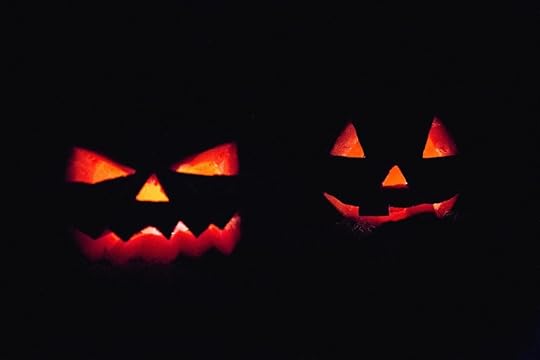
I hope y’all have a great day! Good luck. 
~T
September 5, 2023
Last Quarter Update!
How is it already the last part of the year? Crazy.
For me, September is the official start of spooky season.  I start watching all of my favorite spooky shows and reading spooky books.
I start watching all of my favorite spooky shows and reading spooky books.
The weather may or may not cool off some (in the South, you never know!) and schools are back in session. Since we homeschool I was able to plan our schedule out to have a longer break this month. We’re excited about that. We’re keeping things simple this school year because we have a lot going on (upcoming move, declutter, family time, etc.) and we need simple.
Homeschool
This year we have an 8th-grader and a 4th-grader. I’m using Bible, history, and science curricula that they can do together (at their own level), they will each be doing their level of IEW’s Structure & Style and Fix it Grammar, and they each have their own math curriculum. I also found reading journals that I love and we’ll be reading some classics, biographies, and spooky stories together. They have a few extras that they each want to learn (dinosaurs, birds, Astronomy…). Art, Music, Computer/Typing, Languages, and P.E. Are on the schedule as well. And don’t forget extracurriculars! See? Simple. 
I’m leaning towards rotating two main subjects a day and rotating the other subjects as well and attempting a 4 day work week with the fifth day being a make-up/errand/field trip day.
Writing
My writing hasn’t been in the forefront. I’m working through Julia Donaldson’s BBC Maestro class on picture books. I love her books. I’ve taken several writing classes, but I feel like working through one with a particular book in mind helps to bring about ideas of things it’s missing or needs help with. I’m taking lots of notes so when I do sit down to write, I’ll be organized. 
I started a newsletter! Two actually. You can now sign up for Books by Trista and/or Mississippi Folklore newsletters to get all the latest updates and news sent to your inbox!
Stepping Books by Trista down to once or twice a month and Mississippi Folklore down to twice a month has been what I’ve (and my team) needed for this season, but MSF is still growing and changing and I’m looking forward to focusing on it a bit more in the future. I still love editing for Writing from the Peak, too. If you haven’t already, check these out and give them a follow if you like. It will be appreciated and I think you’ll enjoy.
I’m working on my guided prayer journal and other planners when I have time. I’ll keep y’all updated. Here’s what I have so far.
I recently updated my website. Y’all check it out and let me know what you think!
I guess that’s it for now. I’d love to hear your thoughts on the blogs and hear about what you’re working on or (if you homeschool) what curricula/schedule you use.
K. Now let me go finish that time management book.  Y’all take care and keep lookin’ up.
Y’all take care and keep lookin’ up.
God bless,
T
August 25, 2023
Submitting Work to Magazines
I recently decided to submit some of my work to a children’s magazine, which you may already know if you follow me on FaceBook. I followed the guidelines meticulously. I’m pretty familiar with their work, and I thought my submissions in fit well.
But apparently they did not. The editors were very kind about it and even sort of complimented one of my submissions, but ultimately wished me luck elsewhere.
Man, I have never had so many regections! I’m on to 7 of them now.
But I’m not too discouraged. They haven’t accepted any of my submissions… YET. And they may not, but they’re going to be very familiar with my work and my name.
 Not my image. Credit to whomever it’s due.
Not my image. Credit to whomever it’s due. 
So, this post isn’t to tell you how to submit to magazines, but rather to encourage you to do it. You may get several rejections or they may accept every submission you send them, but you won’t know until you give it a shot!
Put your hard work out there. I’m routing for you.
I had a few more author interviews lined up, but I haven’t heard from the interviewees. I should probably follow up on those. I’ll letcha know how that goes. 
I will (hopefully) have a new book out soon. Fingers and toes crossed and prayin’ all goes well. 
Y’all keep lookin’ up. XOXO
~T
July 31, 2023
Author Chat with Joanne Moore
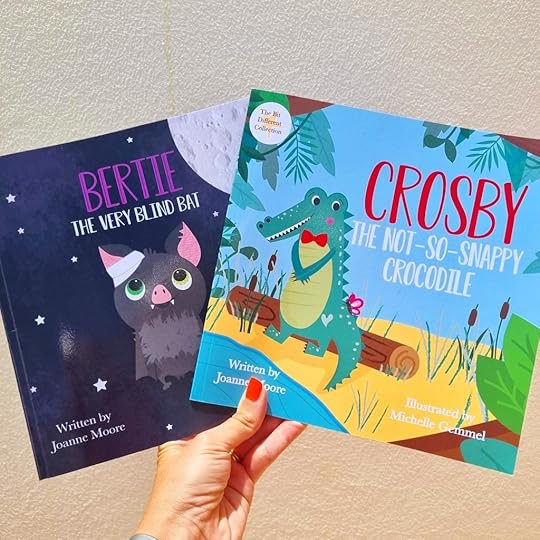
And I’m back with another interview! This time I caught up with the lovely Joanne Moore. I think y’all will agree that her books are adorable and you will want to grab them for your kiddos.
Trista: I love the title of your book series! What’s the story behind the titles; do you have more in the works?
Joanne: The book series is all about differences, all kinds of differences: medical, behavioural, physical etc. I wanted to write inclusive books that will: 1. allow those children with differences to feel understood and accepted. 2. encourage all children to feel at ease around differences and medical issues. 3. help children to recognise that we each have our own differences, but everyone deserves to be treated equally. My aim was also to provide parents and teachers who may need to explain differences of some sort to a child with a useful resource that they can rely on to help them introduce these sensitive topics in a gentle, and fun way.
Trista: How has your background as a teacher affected your writing?
Joanne: Throughout my teaching career and my roles in pastoral care, I have witnessed first-hand the impact that prejudices, bullying and exclusion can have on people. It literally would hurt me to observe or talk to the students (age 16-18) who felt different or misunderstood, and who isolated themselves or were excluded as a result of this. I just always wanted those students, and students who had disabilities or medical conditions to feel confident, understood and equal, and be recognised for their positives and strengths. This understanding needs to be taught to young children, which was a contributing factor to me deciding what I wanted to write.
I have had the absolute pleasure of working with SEN young adults during my teaching career too and I always felt extra protective over these students, who were quite vulnerable. The thought of someone being hurtful to them in any way broke my heart. If everyone got to know some of these young adults that I worked with, instead of avoiding them because they were different, they’d be amazed at what they learned about themselves, and how differently their outlook on life would become. So, my teacher role certainly had an impact on my writing: children need to be taught from a very young age to be kind, accepting and inquisitive when it comes to differences so that they grow up to be inclusive and respectful young people and adults.
Trista: When did you know you wanted to be an author? What steps did you take to become one?
Joanne: I loved writing when I was younger, poetry in particular. I actually kept lots of my childhood poems in a scrapbook and said that I’d one day get them published. When my eldest daughter was little and I read to her, I would often think about being an author, but I just didn’t get any time to focus on any writing that I started. I actually wrote my first book for this series (not one I have yet published) when my youngest daughter was a toddler (she is now 9). This was when I decided exactly what I wanted the overall theme for my books to be.
The motivation came one morning when I realised that I needed to gently start to explain my own medical condition to my daughter (I have a chronic pain condition, and a more recent diagnosis of epilepsy). That morning, I thought about how many other parents (and teachers) perhaps have to explain medical issues/disabilities/differences to their children, so I stayed up all night writing draft 1 of my first book for this series. What better way to explain sensitive topics then through books with positive stories, lovable characters, and gorgeous illustrations?When I decided to end my teaching career, I set myself a goal of getting at least one of my books published, and here I am! I had to do a lot of research on self-publishing as my starting steps and this took a lot of time (and was quite overwhelming and scary). I didn’t know any other authors at the time, so all of my research literally came from independent reading.
Trista: What’s your writing process like?
Joanne: Many of my books are drafted, or part-drafted already. As soon as I publish one book, I decide which book I want to publish next and I then focus on re-drafting and perfecting that. I really enjoy this stage, but only when I have time to sit quietly by myself without being distracted, and it’s not always easy to find that time, so a lot of my writing is done/has been done in the middle of the night/early hours of the morning. I then call in on my ‘saviour’ (my editor) who sprinkles her magic by helping me with my grammar and punctuation (which I do struggle with) and I re-draft using the suggestions that she makes. This stage is hard, time consuming and, can be frustrating: you can feel so close, but so far all at the same time. From there, it’s illustration time.
My first 2 books were illustrated by a friend of mine who always fancied illustrating a children’s book (so this was a great goal-fulfilling opportunity for us both: bucket list ticks)! For my newest book, I have gone in a different direction when sourcing an illustrator. My friend did an amazing job; however, she is so busy running her own design business it was going to become more challenging for us to meet deadlines and work well collaboratively on future work. After illustrations are done and I am happy with them, the final part of the process is getting book samples printed, approving them or making adjustments then BOOM …. hitting ‘publish’ and taking a breath! (From there, you wait anxiously for the first sale/review/comment etc – terrifying).
Trista: What are some common traps for aspiring writers?
Joanne: I think the most common trap for writers who go down the self-publishing route is failure to have a clear view of what to expect:
– Expecting to be rich – I still live in a bog-standard semi-detached house with no hot tub or personal chef. Self-publishing a book costs money (and, quite often, a lot of money: especially if you need an illustrator). – Expecting books to be flying off the shelves immediately – one month I can sell a bunch of bunch, the next month may be only a few. (There has been little ‘flying’ going on).
– Expecting it to be easy – simply marketing a book yourself when you go down the self-publishing route is like a full-time job in itself. I wish that I didn’t have to work, so I had time to focus on the books, but I work 4 days a week in a sixth form college.
– Expecting that once you publish, your job is done – you need to market, spend time researching processes and best-methods, looking at how to reach your target audience, keeping up with social media and trends, organising school visits, writing your next book, finding a suitable editor and illustrator etc.Common traps for aspiring writers on the whole are things like: rushing your work in order to just ‘get it done,’ not taking on board advice and feedback from your editor or proof readers, not researching your target audience or suitable publishers, collaborating with the wrong people – researching illustrators/formaters/printers etc and taking recommendations is important.
Trista: Do you subscribe to any writing magazines or blogs?
Joanne: I do, but aside from one writing magazine which publishes information about upcoming awards and competitions, the rest are all websites and blogs by other indie authors who I support. The indie author community is amazing: everyone really supports each other (and this is what often pushes us to keep going at times when things become too overwhelming).
Trista: As a writer, what animal would you choose as your mascot?
Joanne: Hmmmm, well, I actually have 2 little animal mascots already: a plushie Bat called Beryl and a puppet crocodile called Cindy. They are the friends of my 2 current book characters and they come with me to my school/nursery visits. I’d actually love to have my own little entourage of jungle friends, cute pets and aquatic animals as my mascots: all of different shapes, sizes, abilities, colours. However, if I had to pick one animal, I think it would be the animal that is the star of my next book in the series …. I can’t say what that is yet because it’s a secret.
Trista: What is your favorite childhood book?
Joanne: Tough one as it depends what age we are talking about. As a very, very young child, I remember being read a book by my Nanna called ‘The Giant Jam Sandwich’ by Janet Burroway (first published in 1972). She read it to me, my sister and my cousins over and over and we loved it! The first picture books I remember loving are ‘The Tale of Mucky Mable’ by Jeanne Willis, ‘Each Peach Par Plum’ and ‘the Jolly Postman’ by Janet and Allen Ahlberg . I mainly loved the fact that these books rhymed. I have read all of these books with my children too, and I still know the stories word for word, off by heart. I’m also showing my age with these choices aren’t I? For years, I loved the fairy tale ‘The Elves and the Shoemaker’ – I think this book is why I love the magic of having our Christmas Elf come to our house each year.
Trista: What do you like to do when you aren’t writing?
Well, as boring as it makes me sound, I just love spending time with my family. Days out and family holidays where I see my kids having a ball is just my favourite thing. My eldest is a young adult now so she does very little with us (we are too uncool to hang around with). She has grown up so fast, so I will never, ever regret all of the time that I spent doing fun things with her when she was younger. I just want to make sure I do exactly the same with my youngest, before we are too uncool for her too, so that’s what I do. (There is plenty of time left for hobbies, night out and ‘me time’ later in life (hopefully). Ohhh, I do love a cheeky spa day or a little tapas night with friends thrown in every now and then though (child-free).
Trista: If could go back and do something differently as a teenager to become a better writer as an adult what would that be?
Joanne: In term of academia, I worked hard at school, so I don’t think I would change anything that way. I would, however ask more questions to those peers in my classes who did have medical conditions and disabilities about their conditions, so that I had a better understanding of how they felt, what they needed, and what their struggles and strengths were. Back then, you were kind of taught to be inclusive and be kind, but not to ask questions or ‘make an issue’ out of any differences. Nowadays, children are encouraged to be inquisitive and I think, for the most part, people with disabilities or medical conditions would rather be asked questions and feel like people had a better understanding of their illness, injury or impairment.
I think being inquisitive about these things is important. So, having an earlier understanding of how other teenagers felt about what makes them different would certainly have helped my writing now for this series. (It’s not quite the same, but I have heterochromia, which is 2 different coloured eyes. I was always very conscious of them as a child, and had been teased and called names many a time. I still feel really uncomfortable if I am talking to someone and I can see them stare at my eyes without mentioning them, I’d much rather someone say “hey, are your eyes 2 different colours”). So, having an earlier understanding of how other teenagers felt about what makes them different would certainly have helped my writing now.
Trista: What’s your favorite word?
Joanne: Funny you should ask this as my youngest daughter and I often discuss our favourite words and what we love about them (usually when we are reading books together). I think doohickey is a fave as it just sounds so fun, and it’s not one that I ever actually hear people say (aside from the American YouTubers that my daughter watches). I also love the word aluminium, but only when it is pronounced in the American accent, which is how we pronounce it as home even though we are British …. just for fun!
Trista: What’s your favorite story element?
Joanne: Rhyme. Just nice flowing, well structured, consistent rhyme with flawless cadence!
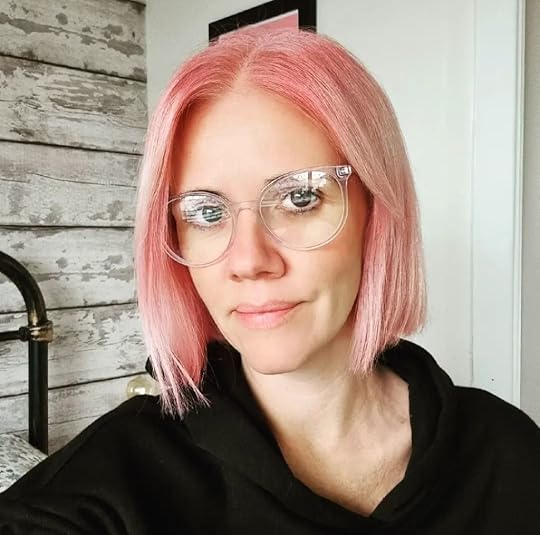 Author Joanne Moore
Author Joanne MooreJoanne, I truly appreciate you taking time for this interview!
Readers, if you’d like to know more about Joanne and her books, you can visit her website or follow her on FaceBook and Instagram.
Don’t forget to comment, like, and share this interview to help an author out! Thanks so much for reading.
Y’all take care and keep lookin’ up! ~ T
July 11, 2023
Interview with Author Michelle Wang
Good morning, everyone! I hope the skies are sunny wherever you are. It’s been rainy here, but I like the rain, too, so that’s ok.
You may recall from recent interviews or my post last October that I promised an interview with author Michelle Wang–and here it is!
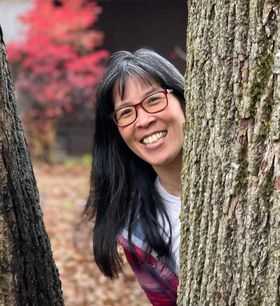
Trista: Thanks for joining me, Michelle. Tell us about your first published book? What was the journey like?
Michelle: My first published book is called It Must Be Autumn and the journey began a long time ago, in a galaxy not so far away (well, technically, this one )  I was looking for a book to read aloud to my Grade One class about the signs of autumn, but couldn’t find one. A few days later, the recurring rhyme and book idea that I had wanted to find in that library somehow found its way into my head where it rolled around for a while until I finally scribbled it down and promptly went back to living my life.
I was looking for a book to read aloud to my Grade One class about the signs of autumn, but couldn’t find one. A few days later, the recurring rhyme and book idea that I had wanted to find in that library somehow found its way into my head where it rolled around for a while until I finally scribbled it down and promptly went back to living my life.
Over the years, in spurts and stops, I endeavoured (but failed) to have artist friends and even my own children illustrate my book. Doggedly encouraged by my older sister (many piles of “how to publish” material that she gave me can still be found in various corners of my house) and my decidedly un-tiger mom (“You should write a book.” was all she ever said), it wasn’t until I crash landed into the 2020’s with the rest of the world that the stars aligned and gave me a swift celestial kick in the butt to actually go get this done.
In quick succession, I read my hand-drawn prototype to colleagues, their classes, and anyone who would listen. I was rewarded with overwhelmingly positive feedback. Through Fiverr and from across the world, the book was beautifully illustrated by an artist who had clearly found a way to pluck pictures directly from my head and onto the pages of my book. (Failure, take that!) The final step was to format, upload, and hit publish. (Marketing? Well now, that’s another completely different kind of journey.)
Trista: How inspiring! How many books have you published? Do you have a favorite?
Michelle: I’ve published three books in the series so far. I kind of love them all but if you held a bag of skittles in front of me and made me choose, I’d have to say the first one, It Must Be Autumn, only because for so long, I never really thought that it would ever become a real live book. (And also, red. No, yellow. Wait, green…..)
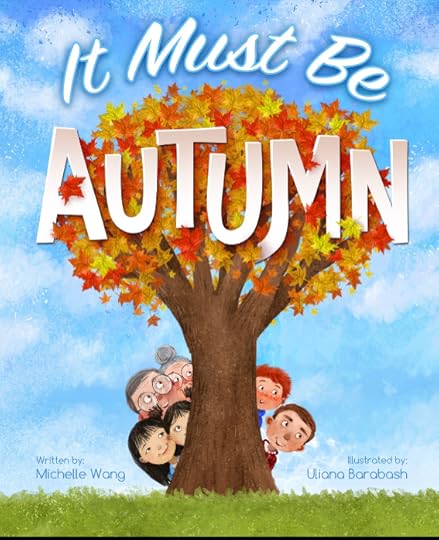
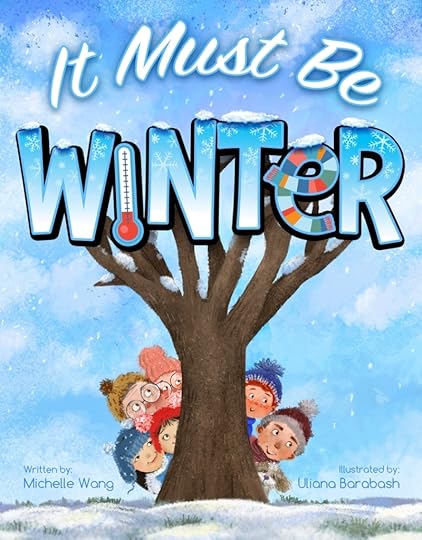
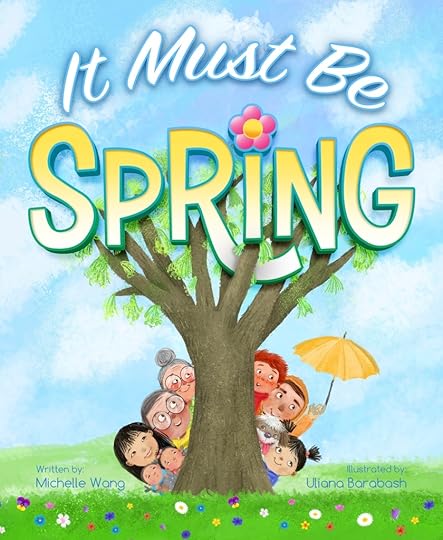
Trista: Have you always wanted to be a writer?
Michelle: I’ve always been a writer in the sense that I love to write and am always writing. I got my first diary when I was 10 – it was red with a gold lock that I’m pretty sure I still have the key for. When my oldest daughter was nine, she started a family newsletter, and I would faithfully write a full length article every month for it. The running joke in our family is that whenever there is an injustice, “mom’s gonna write a letter”. I spend way too much time and care crafting the simplest of emails, and even text messages need to be proofread and revised. I’m known for channeling my inner Weird Al Yankovich when celebrating noteable kilometrestone birthdays, anniversaries, and graduations with personalized parodies of popular songs. But actually writing a book? I guess there was always the inkling that maybe I could one day do something like that, but that one day didn’t ever really seem possible.
Trista: How much ‘world building’ takes place before you start writing?
Michelle: If by “world building’ you are referring to a Westeros or Panem or Prythian, then the short answer is “none”. That said, I never knew how much fun it would be working with an illustrator and adding in the tiniest of details to tell a story within a story. For example, it was Uliana’s idea to make the Mother character look like me. The second book introduces a puppy who is actually my sister’s family pet, Saki. And in the spring book, keen eyed readers will notice baby twins that I always wanted, but never happened in real life.
Trista: What is the most challenging part about writing for you? The easiest?
Michelle: I would have to say just starting is the most challenging. I have a tendency to want to write perfection every time when I should just really put something, anything down and get going. The easiest would be the rest of it.
Trista: How did professional editing influence the development of your book(s)?
Michelle: I have a confession to make: I never had any of my first three books professionally edited (gasp! The horror!) In my defence, I did have it read and reread by as many teachers, students, children, family, friends, and the odd dragon as I could. I’ve also read thousands of picture books over the years as an elementary school teacher and a mother of 4, so do feel I have a good grasp of at least what I would like to see in a book. Having said that though, I recently wrote another picture book which I did find an absolutely wonderful editor for and the experience was one that I will always want to have moving forward.
Trista: What book genre is your favorite? Why?
Michelle: That is such a tough question. For someone who can’t help reading even cereal boxes, I will pretty much pick up anything. I love books with a good dose of humour, witty dialogue, and clever turns of phrases that make me read them over and over again just to savour their brilliance.
Trista: What projects are you working on at the present?
Michelle: I’m working on the fourth book of my series, It Must Be Summer, and am hoping for a first day of that season release date in a few months. I’m also trying to query a book I wrote as more of a gift to my family but feel might actually be a good fit for traditional publishing. I guess we’ll find out.
Trista: What’s your favorite writing tool?
Michelle: Pencil and paper. (But I have figured out how to use those dang-fangled new contraptions called The Laptop, so I suppose that’s a pretty decent tool too.)
Trista: Me, too! There’s something about pencil or pen and paper that gets my imagination flowing. Who is your favorite writer?
Michelle: Oh, again, so many! Which genre? What time of day is it?
Okay, Gordon Korman. When I first read his book It Can’t Be Happening at McDonald Hall and realized that he was just a little bit older than me when he wrote it, he immediately became my hero and continues to hold prime real estate in my book heart even now.
Trista: What do you do when a new idea jumps out at you while you’re still working on a book?
Michelle: I jot it down on whatever I can find (napkin, grocery receipt, notes on my phone) and then hope to heck that I can find it again!
Trista: That’s what i used to do until I started a writer’s common place book! Now there’s no going back for me. LOL What do you like to do when you’re not writing?
Michelle: Watch my kids play sports, read, play the piano, not do housework (except for folding laundry), go to garage sales, laugh out loud (rolling on the floor optional).
Trista: Is there anything else you’d like to say to your readers?
Michelle: I am terrible at self promotion, but I would love to say to my readers: please check out all my books and if you are able and willing to leave a review, it would really help make them more discoverable to new readers. I am also looking for jokes for the summer book so if you have any to pass along, you may see your joke in the new pages! And of course, thank you! (So weird to think that I have “your readers” )
Thanks so much for this interview, Michelle. It’s been a pleasure. Let me know when you have a new release so I can help spread the word. 
Dear Readers, I hope you have enjoyed this interview as well. If you have, please like, comment, and share to help an author out! 
I don’t know about y’all, but I absolutely love the idea of Michelle’s books! You can find out more about Michelle on her website: www.itmustbebooks.com and follow her on social media:
FB: @mustbebooks
IG: @itmustbebooks
Thanks so much for reading. Have a wonderful rest of your day!
God bless,
~T
June 17, 2023
Changing Writing Habits
In the past, I haven’t been the best at maintaining good writing habits. However, I recognize the importance of consistent writing in becoming a successful writer. I have developed a plan to improve my habits, which I will share with you. If you’re struggling with similar issues, perhaps these steps can assist you in cultivating better habits as well. If you’ve successfully mastered your writing habits, feel free to add tips in the comments.
Enhance Your Habits
Find your writing groove. Find your best time for writing by identifying your personal rhythm. Some individuals are more productive in the mornings, while others prefer the night. Utilize your most creative period to maximize your writing. Consider preparing a cup of tea or coffee and a playlist to create the appropriate atmosphere, but make sure the music does not cause too much distraction.Choose a writing area. You want a place that is uncluttered and distraction-free. Writing in the same place each day will help you get in gear.Keep a writing commonplace book (or app) to organize your ideas. If everything is in one place you’re less likely to waste time on searching for that great idea you had the other day or the color of your character’s eyes. This is a place for all things writing–character sketches, outlines, mind maps, random quotes or other tidbits related to your WIPs. Treat your writing like a scheduled appointment. Set aside a specific time in your day dedicated to writing, and stick to it. Avoid scheduling anything else during that time or treating it as less important. You may even want to write it down on your calendar to ensure you remember.Enhance your writing process by allocating dedicated time for each task. Avoid distractions during your designated writing time (such as marketing, editing, planning, or researching). You can set aside separate times for other tasks before starting your writing hour. If one hour seems overwhelming, you may choose a different time frame or set a word count goal instead.If you’re struggling to get started, try writing something short to help get the words flowing. You can prepare writing prompts beforehand that are relevant to what you plan to write about. For example, questions like “What is my character’s current mood?” or “What does my character desire most?” to help inspire your writing. You don’t want this to take up all of your writing time. Plan for 5 to 10 minutes on this. Write! It doesn’t matter if it’s terrible (it possibly will be), just let your creativity take over and get it all on paper. When you’re finished you will make it shine in the editing and revising stages. It helps to work on one story at a time. If you devote your scheduled time to one WIP, you’ll finish it more quickly and be able to move on to the next.It takes about a month for a habit to become a part of your routine. You can train your brain to automatically start writing when you sit down at your desk or wherever you prefer to write. I have gained this knowledge through various experiences, classes, and online challenges. Now it’s time to put the plan into action and alter my habits.
I have consistentally written over the past few months, but not on my WIP. My writing has been for blog posts (Mississippi Folklore and Writing from the Peak), which I love. I’ve also done a lot of editing and scheduling. I need to have separate times for these things as well. I’ll keep you updated on how that goes.
If I don’t prioritize my books, they won’t get written, so it’s up to me to make it happen. I’ll keep you updated on how that goes, too. Fingers crossed! Wish me luck. 
Wishing you all the very best. Keep an eye out for more writing tips, author interviews, homeschool shennanigans, and more, coming soon in future posts!
God bless,
~T
P.S. I’ve had a couple of book birthdays (Halloween Night and Other Poems in May and Zombiesaurs earlier this month) and giveaways to go along with them. Those were a lot of fun and I have more giveaways lined up for other occassions, including one for U.K. readers! Stay tuned!
June 6, 2023
A Chat with Author Carli Valentine
Last October, I featured several authors and their books and scheduled follow-up interviews with each of them. Carli Valentine and her book, The Cutest Pumpkin in the Patch, were among them, and today we’ll catch up with her and see what’s new.
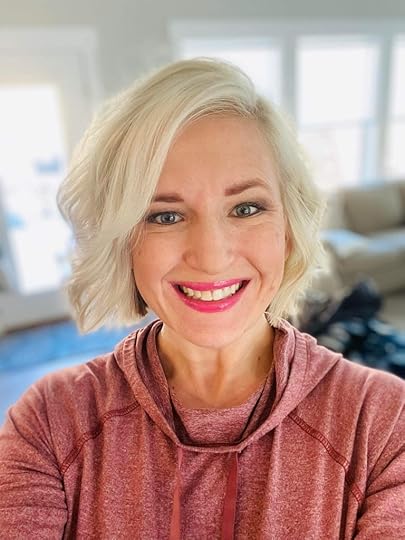 Children’s Author Carli Valentine
Children’s Author Carli Valentine Trista: Hi, Carli! Thanks so much for agreeing to this interview. Tell us a little about your books. How many have you written so far?
Carli: So far, I have published 10 childrens books. I have a lot more though that I have been working on that need to be illustrated and edited.
Trista: Do you have a favorite?
Carli: It’s hard to pick a favorite but I think I improve in my writing and illustrating with every book I produce. If I had to pick one, I would probably choose my newest book, “Later,” Said Gator. It’s about a procrastinating gator that struggles to clean up as he plays. This is the first book in a series I am working on that is great for all kids but especially for those with executive dysfunction and ADHD.
Trista: That sounds adorable! Which has been your best seller?
Carli: My best seller is “Cutest Pumpkin in the Patch.” It’s a fun book to help young kids learn about emotions through pumpkin faces.
My next best seller is “Extra Special Heart.” This book is very inclusive and was created especially for kids with Congenital Heart Defects.
Trista: You have a lovely website. Did you design it or hire someone to do it?
Carli: Yes I do have a website! I designed it myself. I love the creative process and had fun making it. There was definitely a learning curve in creating it though!
Trista: Do you have a writing routine?
Carli: My writing routine varies from book to book. But typically,I pick one of my ideas and start writing the story down as it comes to me. After I get it written I send it to an editor and get their input. After making some adjustments, I begin to illustrate my book. Then, I send it to a proofreader and do all the work involved with publishing so that I can get it out into the world!
Trista: How do you come up with characters and character names?
Carli: I usually come up with character names while writing the story. Certain character traits they exemplify match better with certain names. I also hold onto names when I hear ones that I like so I can remember them and make a list.
Trista: How long, on average, does it take you to write a book?
Carli: It can range anywhere from 1 month-5 months depending on how much time I have to spend on it. It is very labor intensive though. Especially because I illustrate and publish the book myself.
Trista: Which publishing route did you choose, traditional or self-publishing?
Carli: I am a self published author. 
Trista: Me, too! What’s the best marketing strategy you’ve used?
Carli: The best marketing strategy I have used is helping other authors and networking with each other. I believe we get back what we put into the world and if you are giving with your time and help promote other authors, many kind authors will be willing to do the same for you!
Trista: Love that! What has been your best author experience so far? Your worst?
Carli: My best author experience would be receiving emails from families that have told me my book made a big impact in their life! That is what makes all the hard work worth it to me!
My worst author experience would be when I accidentally published a book with a doubled up page. That was very stressful, and I attempted to make it right with all those who bought my book before correcting it but luckily I found out something was wrong and fixed it fairly quickly!
Trista: Does writing energize or exhaust you?
Carli: I think it completely depends on what I am writing about but for the most part when I write my children’s books it energizes me and makes me feel young again!
Trista: Who was your favorite childhood author?
Carli: I loved Roald Dahl. His books always kept me wanting more! Loved all the creativity and imagination that went into them!
Trista: What advice do you have for aspiring writers?
Carli: Keep writing! Don’t make excuses! The sky is the limit! You’ve got this!
Trista: Thank you again for taking the time with me for this interview; I appreciate it and I wish you the very best!
You can learn more about Carli and her books on her Linktree profile and website. You’ll definitely want to snatch her books up!
My goal for Books by Trista Author Interviews is to encourage aspiring writers and to help connect fellow authors with a broader audience. Please like, share, follow, and comment to help an author out!
For more ways to help authors, check out this post.
As a reminder, I’ve cut Books by Trista posts back to once a month for the time being. I’ll have the occasional bonus post, though. Stay tuned for more interviews, updates, and homeschool shenanigans.
Keep lookin’ up.
~ T
May 29, 2023
Hallowe’en in May Giveaway!
I am excited to announce a Halloween-in-May-themed giveaway to celebrate the book birthday of “Halloween Night and Other Poems” and Halloween in May. Together with authors Lee Allen, Lee Call, and Adam Searle, we are offering our readers a chance to win a spooktacular prize box.
The contest began on May 22, 2023, and will run until May 31, with the winner being announced on June 1, 2023.
The prize box includes “Halloween Night and Other Poems” by Trista Herring Baughman, “Sinister Shorts” by Adam Searle, “The Ghost Train” by Lee Allen, and “Good Thing He’s Dead” by Lee Call. I cannot wait to see who the lucky winner will be!
You may recall my interviews with a couple of these guys. Click their names in the previous paragraph to check those out.
There’s still an opportunity for you to join the contest! Simply click on the link below to review the rules. Moreover, it would be greatly appreciated if you could share the contest with your friends who take delight in eerie things. Wishing you the very best of luck!
This contest is for U.S. readers only, but we hope to have a giveaway for our U.K. readers soon, so stay tuned!
Here’s the contest link: Halloween in May Giveaway!
***Remember, the contest is on FaceBook only, so click the link above for details!***
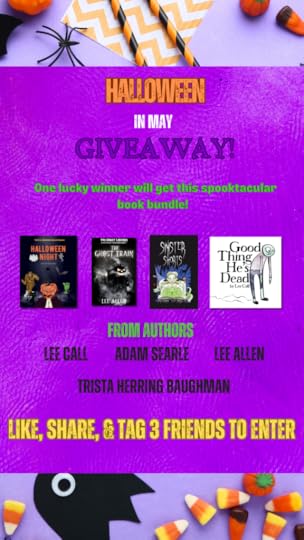
May 2, 2023
A Chat with Author Lee Allen
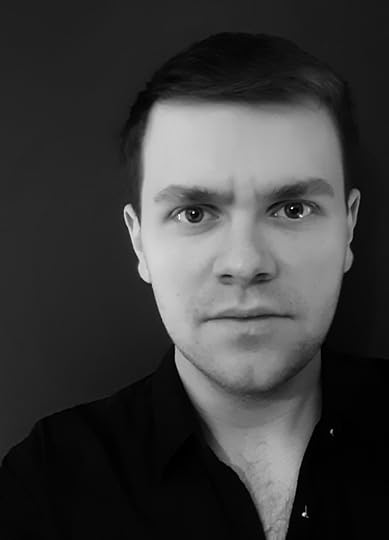
Last month I had the pleasure of making the acquaintance of a fellow author from across the big pond, Lee Allen. I saw a post featuring his children’s book, The Ghost Train, and immediately added it to my TBR. I reached out to him to see if he was interested in an interview, and as luck would have it, he was. 
The Ghost Train is a short story about a man who lost his wife many years ago as she went in search of the legendary Ghost Train, rumored to be the home of a wicked old (very old) witch. He loves his wife very much and is quite lonesome without her. His grandchildren come to stay with him and cheer him up. They’ve heard stories about the ghost train. It doesn’t take them long to resolve to find the Ghost Train and learn the truth for themselves.
 The Ghost Train by Lee Allen
The Ghost Train by Lee AllenI won’t give spoilers, but I did enjoy the read. Lee does a great job creating a spooky atmosphere for the children’s adventure. I like the relationship built between the characters. If your kids are like mine and used to scary stories, they’ll love it. If your kids scare easily, they may not want to read this until they’re a bit older, but if you read it aloud to them, you could skip the more scary or disturbing parts. Fans of Scary Stories to Tell in the Dark and Ray Bradbury will likely enjoy this book.
Below is the interview. Happy Reading!

Trista: Tell us a little about yourself and your published books. Which one is your favorite?
Lee: I’ve always been an introvert. I’ve spent huge chunks of my life as a loner, often feeling like the weirdo or the outsider. Imagination was my constant companion and books my closest friends.
My stories contain elements of the gothic, the macabre and the criminal, in the genres of horror, mystery and thriller, with the occasional shades of romance and erotica. I’ve published six books so far, five for adults and one for children, plus some additional short stories.
I wrote my first full-length crime thriller while still in school, later publishing it as my debut novel “Those Crimes of Passion”, now over a decade ago. My forays into gothic fiction followed with “Alone”, the first in my “Jack O’Lantern” series, “The Jack O’Lantern Men”, and my short story collection “Whispers from the Dead of Night”. I then released erotic horror thriller “Bitten” and two short stories in the “Jack O’Lantern” series. My first children’s book, “The Ghost Train”, was released last year.
I’m not sure I have a favourite really – I’m proud of each book for different elements and probably change my mind frequently as to which I’m most happy with. Perhaps if I were to pick the most personal, I would say the “Whispers from the Dead of Night” collection. I worked so hard on it for eighteen months. There were some difficult times during that period and writing kept me going. There were also many times I felt that I might never get it to where I wanted it to be. But I kept going and I’m very happy with the end result.
Trista: How long have you been writing? What inspired you to start?
Lee: It may sound like a cliche, but I’ve been writing for as long as I can remember.
I’ve always loved books and stories – I love to read and have done since I was a child. I was also very creative, so I think those two things must have come together and I developed a passion for writing ever since I was able to pick up a pen and form words on a page. Add to that the escapism of both reading and writing, of being in your own world, and it’s just the perfect mix. So, I’ve always known I wanted to be a writer.
Mysteries, mythology and the supernatural have always fascinated me. By the age of ten, I had discovered both classic gothic horror fiction – in the form of “Dracula”, “Frankenstein” and the Mummy – and classic detective fiction – in the form of Hercule Poirot, Miss Marple and Sherlock Holmes – and my love of the horror and thriller genres developed from there, while I also became fascinated with true crime and psychology. There was probably never a question as to which genres I would write in.
Trista: Are any of your stories based on local folklore?
Lee: I like to weave folklore throughout many of my stories, though sometimes it is purely fictional. I’ve not used any local folklore in stories to date, though at times folklore from other parts of the world has inspired the folklore I apply in the fiction. I also like to weave in history, religion, and mythology to create these elements of folklore. You’ll find elements of that, especially in my adult supernatural fiction – such as in exploring vampire folklore in ‘Bitten’.
Trista: Do you recommend any writing blogs?
Lee: Most of the ‘blogs’ I follow are actually fellow authors’ Bookstagram and Facebook pages, rather than subscribing to traditional blogs. I find the bite-sized pieces of advice and motivation – or simply a post about other writers’ experiences and updates – are more helpful and inspiring than lengthy blog posts.
I occasionally dip into writers’ memoirs and guide books, as well as subscribing to writing magazines. I’ll often subscribe to newsletters when the option is there to do so. I’m also the member of several Facebook groups. I enjoy being able to connect with fellow writers and readers and social media is a fantastic medium to enable this.
So I suppose my recommendation is actually to connect to fellow writers in whatever way works best for you.
Trista: How many unpublished and half-finished books do you have?
Lee: As we’ve all done, I wrote multiple ‘books’ and stories as a child, but I don’t really count any of those – they were just sketches and doodles.
I have several plots and scenes for multiple books floating around at any given time, all of which I intend to return to. As for books I’ve already started, there are two older ones that are currently unfinished. They’ve not been abandoned, just postponed.
“Bitten” was one such half-finished book when I chose to concentrate on “Whispers from the Dead of Night” in September 2018. Following its release, I returned to “Bitten” and completed it, which I think is the ultimate goal for everything I’ve ever started – even if something may end up looking completely different to how it was first envisioned.
As for completed books, nothing at this stage!
Trista: How did publishing your first book change your process of writing?
Lee: Through publishing my first book, I learnt a lot about the publishing process, formatting, marketing, etc. I’m not sure it necessarily changed my writing process as much as it was one component in the evolution of that process. It certainly energised me to return to writing again, after having written little for several years. It was also the first step in me becoming a better editor too. But I was at school when I wrote my first book, and now juggling writing alongside working full time was something entirely new.
When I published my second book two years later, I was far more comfortable with the process as I was now familiar with it. Every release has brought a learning curve though; in recent years, online marketing and social media have become much bigger elements of my process. It’s simply not enough to drop your book and then walk away. You need to find ways to make yourself seen and heard – and that is probably the most challenging part of it all.
But, as for working on the early stages – planning a story and writing the first draft – that remains largely unchanged to how I’ve always done it. I pick up a pen and get lost in the story.
Trista: Does writing energize or exhaust you?
Lee: Both, undoubtedly! Sometimes simultaneously. I love writing and researching and building my plots and characters. I can sometimes spend hours drafting scenes and writing notes. There are other times when I can barely manage the next sentence – though I believe this is often due to external factors or on days when I’ve allowed doubts and anxieties to creep in, or when I’m being overwhelmed or burnt out in general. Overall, I feel happiest when I’m writing and getting into the next scene always makes me feel happy and relaxed.
Trista: What kind of research do you do, and how long do you spend researching before beginning a book?
Lee: I tend to do quite a bit of research into and surrounding the subjects and themes I want to include in my stories. This could be through non-fiction books, online research, or visits to historic locations or just somewhere similar to the setting for an upcoming scene.
I usually research the next book’s themes in detail before I start, while I then continue to research throughout writing, finally often double-checking details during redrafting. A lot of that research may have no direct impact on the plot or characters, or some research may only influence a small section – perhaps just a sentence. But I think context and authenticity are both very important to a story. Plus it gives me an excuse to order another stack of books for my non-fiction and reference library!
Trista: What’s the best time of day for you to write?
Lee: I try to make notes anywhere at any time. Whether that be on paper or on a computer or smartphone, I try to make a note of whatever has been going around in my head as quickly as possible, as I’m always afraid I’m going to forget. Though considering how many years some ideas have kept coming back to me, I probably shouldn’t worry too much.
When it comes to dedicating time to sit down to write, it’s most often in the evening or later at night. Though if inspiration grabs hold of me for particular scenes, I may need to start writing it wherever I am at whatever time of day it occurs.
Trista: How many hours a day do you write?
Lee: Not nearly as many as I’d like to! Sometimes I’ll only be able to squeeze in half an hour, but sometimes I can manage much longer (though I may suffer for that late night the following morning). I’ve written several books now by writing in these consistent smaller chunks, so it seems to be the best way for it to work for me whenever I’m juggling it with other priorities. Which for most people, is always the case.
Trista: What’s your favorite book?
Lee: I’m not sure about favourites, but there are certainly significant books. Just trying to think of them, the list keeps growing, so I’ll try my best to keep it concise.
“The Lion, the Witch and the Wardrobe” was probably one of the earliest full novels I remember reading independently, or at least what’s stuck in my mind.
I discovered “Dracula” during my childhood years, firstly in abridged child-friendly versions, then through the “Horror of Dracula” film adaptation starring Christopher Lee before reading the full-length novel. A classic of gothic and horror fiction.
I first fell in love with Agatha Christie’s work when watching the “Poirot” TV adaptation starring David Suchet. I was so excited when I discovered a new book collection and snapped up the first issue. “Murder on the Orient Express” became the first crime novel I read and I’ve not looked back since.
Finally, a book series and another entwined with the screen with Lynda La Plante’s “Trial & Retribution”. I read all six novelisations after seeing the sixth series on TV. The way it blended police procedural, forensic science and legal drama, plus a dash of the core characters’ personal lives, felt like getting the best of everything in one mix.
While there are so many more I could mention, these four examples are perhaps the starting points for the various strands of my genres of choice for both reading and writing (and viewing) in the years between then and now.
Trista: What would you say is your most interesting writing quirk?
Lee: Perhaps this isn’t necessarily a quirk, but I like to write all my first drafts by hand. There seems something more traditional and fulfilling about putting pen to paper, working in new notebooks for each project.
It also has its practical uses – I spend all day using a computer for my day job, so it’s far healthier and relaxing to be using pen and paper rather than being back on the computer late in the evening. Typing up what I’ve written I’ve found helps when redrafting, being able to simultaneously review and almost be writing it afresh again.
Trista: Can you share a bit of your current work?
Lee: I’m actually working on two books at the moment – a new gothic horror novel for adults and the second in my “Ghost Legends” series for children.
I’m about halfway through the first draft of my new novel, so won’t say much about that at this stage, other than to say I’m revisiting a character some readers will have already met.
As for “Ghost Legends II”, readers will be catching up with Chloe and Lewis in the next chapter as their lives become tangled with another piece of local legend and dark folklore. I’ll be sharing more details on this one very soon!
Trista: How exciting! I’m looking forward to that. Thank you so much for taking the time for this interview. It’s been nice chatting with you. Is there anything else you’d like to say to your readers?
Lee: I just wish to say a huge thank you to all my readers – thank you for taking a chance on an unknown and indie author, and thank you for all you’ve done to support me. I hope I can continue to keep you entertained with my stories.
And thank you, Trista, for inviting me to appear on your blog for this interview and sharing your thoughts on “The Ghost Train” – it’s very much appreciated!
Well, Dear Readers, I hope you enjoyed the interview! Help me support indie authors by liking, sharing, and commenting.
Don’t forget to check out Lee’s Amazon page where you can grab copies of all his titles.
You can find Lee on social media here:
Check out his brand new website!
I have more interviews in the works, so y’all come back soon! : ) Til then, keep lookin’ up. God bless, ~T
April 17, 2023
The Magic Telescope – Setting
My first book, The Magic Telescope, is about a boy named Seth. He really wants a new Gazer 3000 telescope for his birthday but gets a second-hand telescope instead. With help from his cat, Sinbad, he discovers that it’s no ordinary telescope–it’s magic–and he’s about to experience the adventure of a lifetime.
The setting is an essential story element that includes all the details of the time and place(s) in which your story takes place. I talked about the setting for this story in a previous post which you can read here.
In my last post, I mentioned we had done some traveling recently. While traveling, I got to visit one of my favorite places and part of the inspiration for the home setting in The Magic Telescope.
That place is Walnut Creek Lake in Papillion, Nebraska. The pictures I took don’t do it justice. It was always so nice to go there and reconnect with nature. I’m glad I got to visit even if it was only for a bit. I even use this as a setting in another story I wrote called, The Lake. That one was published briefly on Authonomy. I plan to polish it up and republish it in a short story collection at some point.


The other place that inspired my vision of Seth’s home is my original hometown in Mississippi. There are a few special places on my family’s land where I always loved to hang out and that’s where I envisioned Seth’s getaway spot. I can’t find the good pics on my phone at the moment, but here’s one I took in one of those spots at night a while back. These places will show up in other stories as well.

I got to work closely with the illustrator (although we were miles apart) and he (Eumir) did an amazing job. I gave him descriptions of my characters and he brought them to life beautifully. I think his vision for Seth’s hideout makes me think more of a mountainous region. I’m right at home there, too, actually. I love the mountains. But from the readers’ point of view, I think the beauty of it is they can see this part of the setting in any of the above-mentioned places, or even their own backyard.
I wasn’t able to get pics of Nunamaria on Europa (that’s the moon of Jupiter that Seth and Sinbad are zinged to) , but I did find some neat pics on Nasa’s website.
, but I did find some neat pics on Nasa’s website.
 Image from Nasa
Image from Nasa They say writers should write what they know. I know these places well and they’re all a part of me. I can’t help but write them into my stories. I’ve learned a bit more about writing and world-crafting since I wrote my first book and I can’t wait to put that knowledge to use. Sometimes it’s difficult to find the time to write. It’s 1:58 as I’m typing this. Sigh. 
But rest assured, I am working on more stories. I’ll talk more about setting in my other books in posts to come, good Lord willing. But next up I have a few more author interviews. Keep an eye out and keep lookin’ up.
If you would like to grab a copy of The Magic Telescope for your favorite young reader or yourself, it’s available at Barnes & Noble and Amazon. Thanks for taking time to read this.
God bless,
~T

